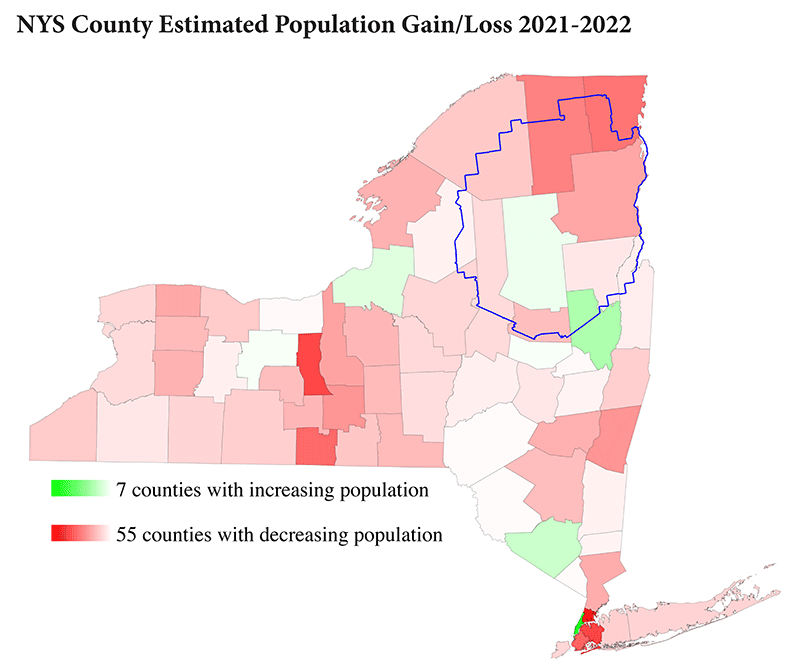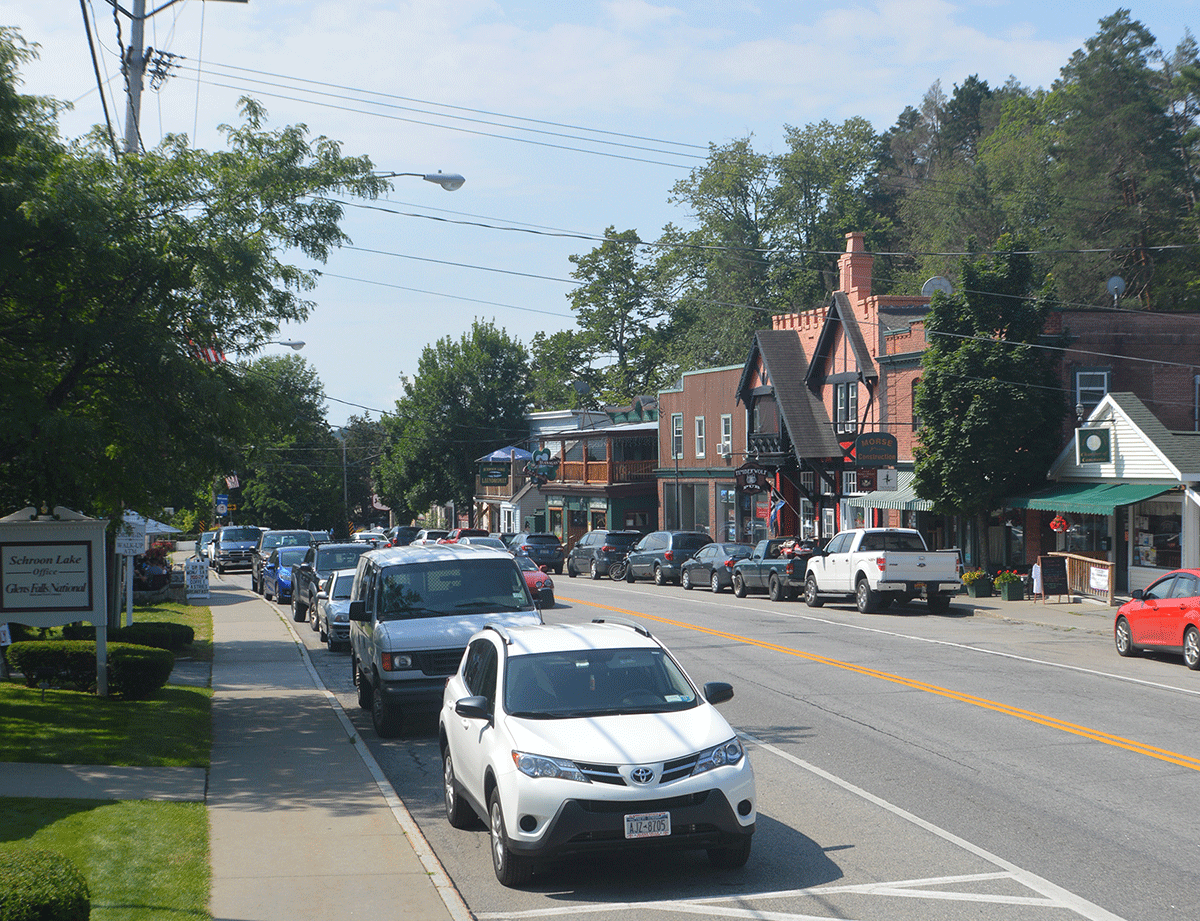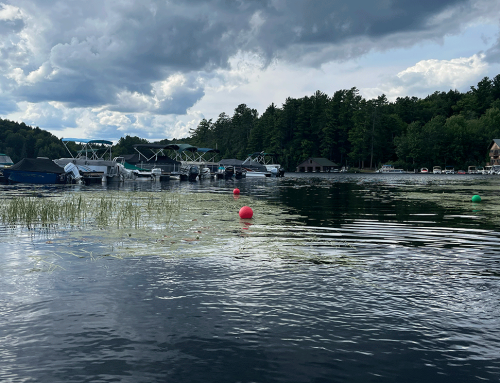The US Census recently released its estimates for changes in U.S. population for 2021-2022. These are estimates that are based on samples and models from across the country and are not the complete counts that we see with the decennial census. This new estimate for New York State projected that the state lost just over 180,000 residents in the last two years, with losses projected from every part of the state. Across New York, 55 of the state’s 62 counties were estimated to have lost population.
Now, be advised that we should all take these estimates with whatever grain of salt that one chooses. Remember that throughout the 2010-2019 decade, the US Census estimates had New York State losing population, estimate after estimate, but the actual 2020 decennial US Census recorded a gain of over 800,000 new residents for the decade. The 2020 US Census was an important correction to the series of big misses from the estimates since 2010. There’s a difference between estimates that model a variety of samples and the actual counts undertaken every 10 years. This is also just county-level data; estimates are not done at the town level.
Nevertheless, the 2022 US Census estimates represent our country’s best work to try and capture and portray national trends. Moreover, there’s often accompanying hoopla about doom and gloom scenarios based on these estimates. The 2022 estimates show an intensification of trends that we saw in the 2020 Census of growing metropolitan areas and shrinking rural areas. The 2020 Census was historic because it marked the first time in American history that a majority of counties lost population. Though the U.S. gained over 25 million people from 2010 to 2020, those gains were concentrated overwhelmingly in specific regions of the country and metropolitan areas.
Some will grab the 2021-22 estimates and use them to indict the abundant Forest Preserve, existence of the Adirondack Park, and land use plan of the Adirondack Park Agency as proof that all things Adirondacks are going to hell, but those making this case should be cautious. First, as noted above, 55 of New York’s 62 counties are estimated to have lost population. There’s no APA in the Southern Tier or Brooklyn, and they both are estimated to have lost population. Second, across the Continental U.S., excluding Connecticut where the data is not usable, among the 3,015 counties with estimates, 1,648 were flat or were estimated to have experienced population gains, while 1,452 saw losses, so there’s plenty of company on the downside. Last, the 2022 estimate actually shows a minor overall population loss for the U.S. as a whole, a net loss of several thousand. With the deaths of over 1.1 million Americans from COVID, one has to wonder how that factored into our population dynamics.

Map shows US Census estimated population gains or losses in US counties. Map by James McMartin Long.
The biggest question mark for me with the 2022 estimates is the county level population gain or loss projections. In 2022, it’s estimated that over 1,600 counties posted population gains, just two years after the much more rigorous 2020 US Census that found that the majority of American counties had lost population. In 2020, 1,650 counties posted actual losses. One has to wonder how much of COVID-driven modelling of flight to suburban and rural areas, that may or may not be case, is figuring into this calculus. Such a stark reversal for hundreds of counties from loss to gain in a 2-year period raises a lot of questions.
As stated above, New York State is estimated to have 55 out of 62 counties with population losses. These estimated losses ranged from a low of -0.029% in Delaware County, with a projected net loss of 13 residents, to -2.895% in the Bronx, with a projected loss of over 41,000 residents. These estimates are different from the 2020 US Census, where Upstate counties saw a minor drop, and New York City posted most of the gains. In the 2022 estimates, four of the five New York City counties were projected to have lost population: Queens at -2.15% (loss of 50,112); Kings (Brooklyn) at -1.78% (-46,970 residents); Richmond (Staten Island) at -0.47% (a loss of 2,351). New York County (Manhattan) was projected to have experienced the state’s largest gains at 1.1%, with some 17,472 new residents.

Map shows US Census estimated population gains or losses in NYS counties. Map by James McMartin Long.
Adirondack Park counties figured in both the Top 10 for estimated gains or minimal losses, and the Top 10 for estimated losses in New York. That’s the Ying and Yang of Adirondack life. Among the seven counties with projected population gains in New York State was Saratoga County, estimated to have grown at 0.35%, attracting over 800 new residents. Hamilton County clocked in with a projected 0.078% growth rate, with an estimated net gain of 4 residents. On the other end, Clinton (-1.55%) and Franklin (-1.41%) counties posted losses. Clinton County was estimated to have lost over 1,200 residents, Franklin County over 600, and Oneida County nearly 1,100 residents. Each of these counties host major state prisons, so we have to wonder how much the continued drop in the state’s inmate population factored into their estimated losses.
Essex County is estimated to have seen a -1.02% drop (-382 residents); St. Lawrence County -0.62%; Lewis County -0.17%; Oneida County -0.47%; Herkimer County -0.43%; Fulton County -0.72%; Warren County -0.26%; and Washington County -0.22%.
The saying used to be “as goes Hamilton County, so goes the Adirondack Park,” but that’s not quite the case. In the 2020 US Census, Hamilton, Saratoga, and Warren counties all posted net gains, while the other nine Adirondack Park counties experienced losses. Overall, the population for the 12 Adirondack Park counties was basically flat for the decade 2010-2020.
One part of how the Census models its population estimates is a comparison of births and deaths. When we look at the twelve Adirondack Park counties together deaths exceeded births by over 1,500. We’ve written widely on this demographic reality that dominates life in Rural America in the 21st Century. (See here, here, and here.) Baby Boomers are aging and dying, and it was the Baby Boomers that dramatically expanded rural populations in the 1950s-1980s. The children and grandchildren of Baby Boomers either had, or are having, smaller families. The reality is that across many parts of Rural America we have just as many adults of childbearing age as we did in the 1980s and 1990s, but they are having far fewer children.
Though there are questions with the 2022 US Census population estimates, they reinforce defining trends for the Adirondack Park and Rural America that will persist for the next two decades or longer because there’s not much that we can do to stop old people from dying or to force younger people to have more children.






